
Making Medieval Parchment
For Books and Pages
© Randy Asplund
|
I am writing a book about how books were made in the middle ages, and
you can't have a book without the pages that go into it. So I decided
that my scope would include the method of making medieval pages from
parchment. Parchment is animal skin, most usually the skin of goats,
sheep or calves. The later is often called "vellum." I started
researching the techniques, but nothing in my book will be untested, so
I had to teach myself to do it just as it was done back then. Its a messy job, but a lot of fun. The added bonus is that instead of spending $20- $40 per square foot on someone else's parchment, I can make exactly what I want at a much lower outlay of cash. Nevertheless, it still requires a lot of effort, as you shall see here...  We start with very fresh goat and sheep skins from the slaughterhouse. They are soaked to loosen feces, dirt, blood and other filth. 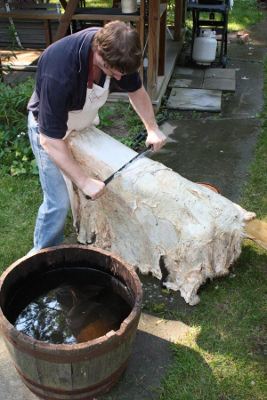 I
made Fleshing knives for the next step. Here you see me demonstrating
how to plow off the connective tissue and remaining meat. The wood beam
I am working over is a traditional and ancient device for this purpose.
I made it by splitting a log.

Some of the workshop students busy at the task of removing the flesh.
Each student worked on two skins over the course of three weekends.
Some came from as far as Indiana to do this.
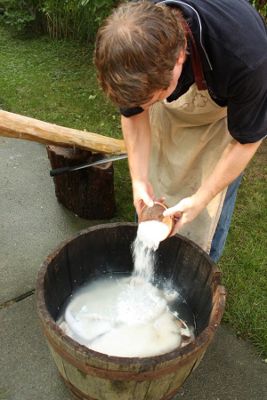 Next, the skins are put into the first of two soakings in water mixed with hydrated lime. The first soaking will loosen the hair from the pelt. They will be agitated and turned three times every day for over a week. 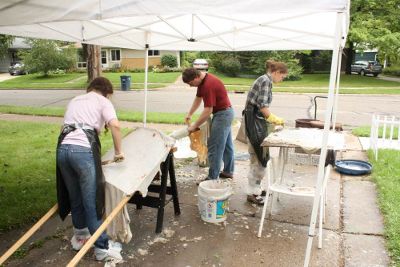
Here we are using a few different hand methods to remove the hair. I am
working on the beam with a dull wooden rod, the woman on the left is
working on a broader makeshift beam that I constructed from curved
plywood and rails, and my wife Ann is just scraping it away on a flat
table with a plastic kitchen scraper. They all work well. When we
finish, the skins go into the lime bath again.
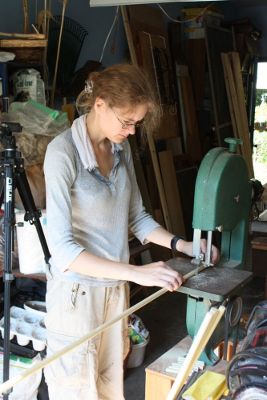
Each student had to make two frames 5x7 feet, with holes for 30 pegs.
Here Ann is cutting dowels to make the pegs that serve to attach the
skins to the frames.
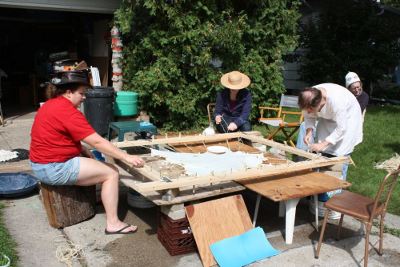 It
is quite a job to attach the skins to the frames. We pushed small
round(ish) stones through from the flesh side and caught them in loops
on the hair side. These slip knots were tightened, and then the cords
strung out to wrap around the pegs. The pegs are turned to tighten the
skins while we scrape them.
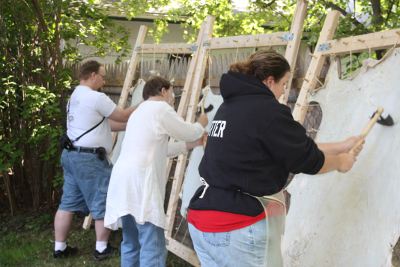
Here are some of the students working hard to scrape tyhe skins thin
while they are under great tension. The crescent shaped knife they are
using is a lunelarum based on a 12th century design. I commissioned my
friend Alex Gleason to make them for me.
 The
skins are scraped as smooth as possible with the knives and then we
sand them down. This is me sanding with a pumice block that I made. Ann
felt it worked better than the power disk sander, but as long as it is
very thin, that's what counts. A good parchment is as thin as light
weight modern printer paper. After the sanding we wet the skin
lightly and wipe it down with another pass with the lunelarum to make
sure it is really smooth.
|
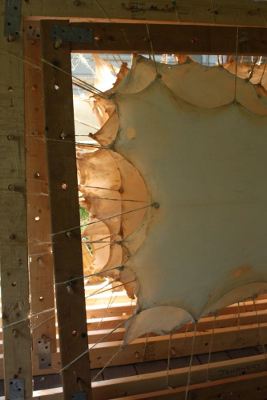 I
wet the skins completely and then tighten them down as much as they can
stand. Then they are set aside to dry. As they dry under tensin they
become whiter and they become more opaque. No longer just rawhide, they
are now finished pieces of parchment, ready to be cut into pages. It is
a freakish amount of work, but the feeling of accomplishment is great!
|

The last thing to do is to cut the sheets from the frames. They can
then be rolled for storage. If you want to see more about the process
for using them in books, my article on making the book Ecclesiastes
shows the steps the scibe takes to use them.
You have only seen a sample of the process. There is more to it than what you see here, and it will all be explained in my book Secrets Of Forgotten Masters: A 21st c. Arist's exploration of the technological processes used for making illuminated manuscript books from 700-1500 in Western Europe. |